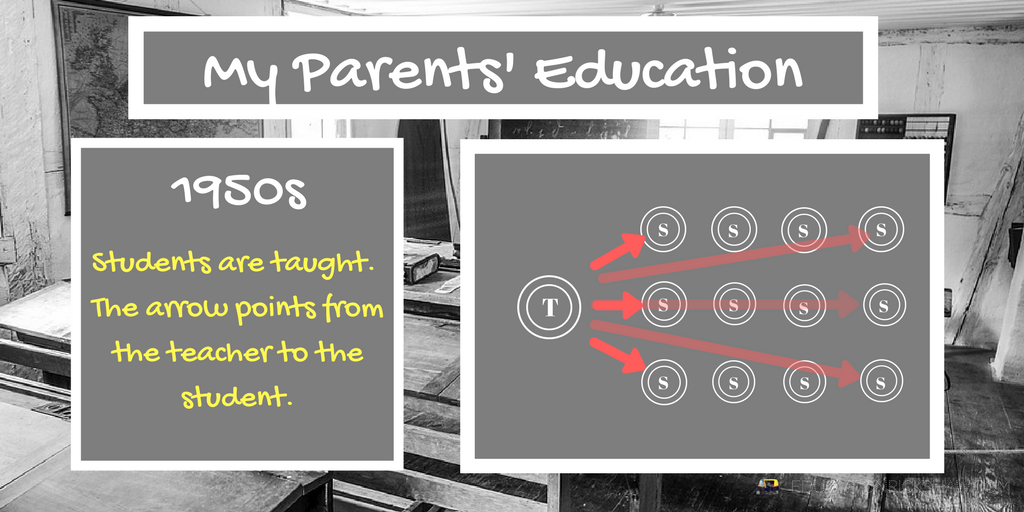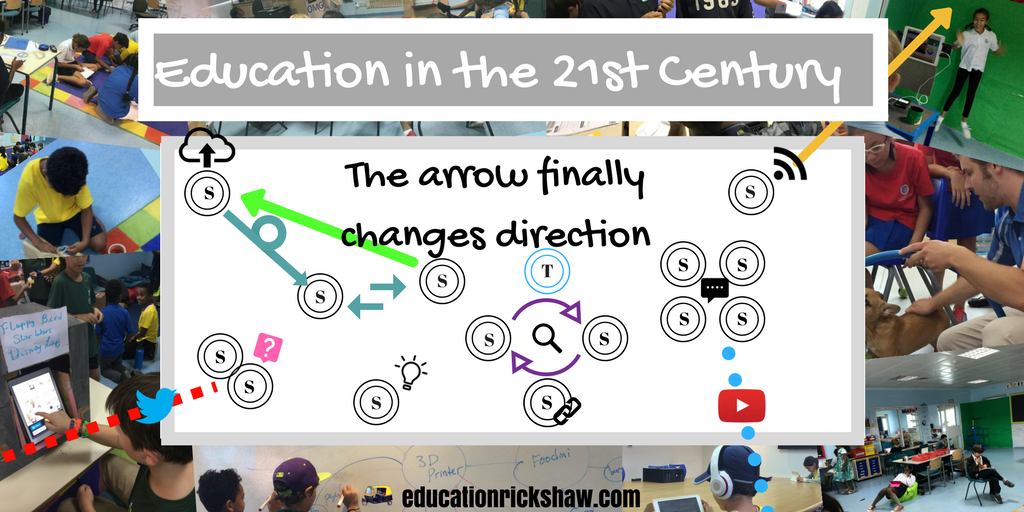Thank you for visiting educationrickshaw.com! My name is Dr. Zach Groshell and… I wrote this blog a while ago and I no longer agree with many of the points in here! I could delete it, but then I’d never be able to go back and compare what I used to think with my current beliefs on teaching and learning. Please check out my latest posts and podcasts, and thank you for your interest in my work!
In looking back at my parents’ education in the 1950s and 60s, and my own education in the 1990s and 2000s, I worry sometimes that despite the huge advances that we’ve seen in technology, not much has changed when it comes to how we view learning and how we design learning environments. The transmission model of education is still the name of the game, although in some circles there are signs of its erosion.
I would like to take you on a journey in this post, starting from the 1950s banking model (Freire, 1968) of instructional design, before comparing it to my own schooling experiences as a digital native at the turn of the century. Then, finally, I would like to share my vision for C21 learning, and propose some ways that we can move forward so that we are meeting the needs of today.
When my parents went to school….

In each of these infographics, students are shown as (S) and teachers as (T). The important focus in each of these images is the direction of the arrow. By looking at where the arrow originates and where it is pointed, we can ask ourselves, Who is doing the thinking? Who is actively using language? Who is leading? What is the relationship between the student and the teacher? And since learning is the ultimate goal, Is learning happening? and Is this how students best learn?
In an industrial-age classroom, with a teacher-centered/teacher directed, one-size-fits-all approach, the arrow always points from the teacher to the student. The directionality of the traditional teaching arrow doesn’t differentiate to allow for students to learn from any source but the teacher and the resources prescribed by the teacher. The roles are clearly defined: It is the teacher’s job to create memorable lessons, and the student’s job to remember them whether or not they are memorable.
The only positive spin I can put on the 20th century compliance model is that learning can potentially happen despite the teacher’s illusion of control. My mom, for example, was a Deaf student learning in a 1960’s hearing world. She recalls how she would resort to sneaking notes to ask for help from her peers before being caught and punished by her teacher. According to her, and countless other students with similar experiences, it was the help of peers or an adult tutor that saved them from what could potentially have been a lost education. Of course, reconceptualizing the entire learning model to one that allows for personalization and multi-directional dialogue would have done the trick as well.
Now, if you think that things got better for us millennials circa Y2K, I am sad to report that by the time school started for me in 1992, the directionality of the arrow had barely changed at all.
When I went to school….

Let me paint a picture of what it was like when Stephanie and I attended school. In almost all of my classes growing up, teachers put us in groups of 4-6 desks like those depicted above. There were 6-8 iMacs collecting dust around the perimeter of the classroom, and class sets of simple word processing laptops on wheels. We had book bags and class libraries, and we took brain breaks and played learning games, too. There was an increased understanding on the value of pastoral care and differentiation, although they didn’t call it that. Despite an overall appearance of progress, the teacher still held the cards. The direction of the arrow didn’t change; It still went from teacher to student to nothing.
I don’t want to devalue the work that was being done by a handful of forward-thinking teachers in my life. If it weren’t for them, I wouldn’t have entered the profession. But for the majority of my experience, the focus was on making traditional teaching work for the 21st century, not on shifting the paradigm. Yes, my generation’s instructional methods included “turn and talk”, for example, where we were asked to turn to a partner and mindlessly babble fake discussion, with one eye on the teacher to make sure she wasn’t coming around. Then, when “talk” time was up, we would just share what we were already going to say before the exercise began. This is how we did “discussions”; We were allowed to talk to a partner for 15 seconds, and then those selected by the teacher were allowed to share before the teacher took back the reigns once more.
Again, the arrows of my education were not much different than the linear, teacher-controlled, unidirectional arrow that formed the education of my parents’ generation, and the generations of organized schooling that existed for 100 years before. In order to truly reject the pedagogy of the 20th century, which may have been adequate for the time, we literally have to make a 180° turn and run the other way.
My dream for school….
It’s time to change the direction of the arrow by for once and for all turning it around and allowing it to originate from the student. Imagine a classroom where students are the ones driving the learning and are empowered to pursue things that matter to them. In the infographic above we see multiple modalities being employed by these students as students are accessing human and digital resources to drive their own learning. In a 21st century learning model, learning extends beyond the classroom walls, and students are exchanging, discussing, questioning, reflecting and making connections anywhere, anytime. Most importantly, students are inspired and empowered to act, rather than sit back and have the knowledge brought to them.
Ideal classrooms always change, are a mess & have no teacher desk. They encourage interactions & personalization. #africaed #kicslearns pic.twitter.com/mnAPoa6hJw
— Bradley Arnold (@leybradly) September 14, 2017
This learning is so nonlinear, publicly shared, and student-driven that there is no silver bullet for how to achieve this in your classroom overnight. I’m still learning and reflecting on how best we might do this, and I don’t pretend to have arrived the proverbial mountaintop of understanding. Regardless, here are some things I’ve tried in my class to change the direction of the arrow, with a related blog post explaining below:
-
Imagine, envision, predict what the classroom of the future will look like: What Does a 21st Century Classroom Look, Sound, and Feel Like?
-
Break down walls, timetables, and barriers to learning. Throw out the traditional playbook! How to Set Up a Week of Free Inquiry for Anywhere, Anytime Learning
-
Don’t just think about giving your class back to your students – DO IT! 5 Ways to Give Your Class Back to Your Students
-
Empower and inspire students to make their own creative contributions. Empowering Students to Take Creative Action
-
Give students voice and choice by making the time for student-led reflection. 5 Reflection Activities to Help Students Glow and Grow
-
Be wary of traditional learning “repackaged”. That digital program your school bought will never transform learning
With the world of knowledge now available at our students’ fingertips, and in a time when we’re certain that the workforce of the future is going to look completely different from what it does now, it’s time to reject the status quo of how we design learning opportunities for our students. Seeing as we are already well into the 21st Century, my hope is that once and for all we put an end to the 20th century mindset of the teacher as the keeper of knowledge and our students as the passive consumers of information.
– Zach Groshell @mrzachg
You’re welcome to join our facebook group, Over-posting Educators.




We cannot give the classroom back to the students while we still have standardised testing. The students must jump through the hoops set by GCSEs and A Levels. Student-led enquiry learning does not lead to the same academic achievements as teacher led learning. The teacher is the expert the topic the students are not.
LikeLike
Could not agree with you more, Mary!! And here in the U.S., students take on average 17 standardized exams just in high school (aka secondary). I graduated high school in 1976. In my entire school life, I was required to take only 8 standardized exams. They are not helping – they are doing just the opposite. I teach high school students now. Apart from the PSAT (taken 3 times), they take the SAT, the ACT, MAP exams, and STAAR/EOC exams (state exams). And that’s apart from those students who also take Advanced Placement exams. As long as we are forced to teach to these exams, we will not be able to throw out the old playbook.
LikeLike
Yes yes yes
LikeLike
I want to create a school where there is no standardized testing. should I start a private school?
LikeLike
I read a lot of blog posts and I never heard of a topic like this. I Love this topic you made, really amazing.
LikeLike
Hi! That was actually made by Zach Groshell – Stephanie Groshell is his wife! Cheers, and thanks for linking up!
LikeLike
Thanks for linking up. Enjoyed reading your post 🙂
LikeLike
Great article, thanks for linking up.
LikeLike
I love this article and could not agree more with your ideas.
I teach Reception year in the UK which is 4- 5 year olds. I am part of a growing movement to introduce true child led learning into our classrooms. We are having to compromise and make changes to satisfy the demands of the curriculum but we are determined to do better every year .
We are following the ideas of Anna Ephgrave, Greg Bottrill , Elaine Bennett among others.
X
LikeLike